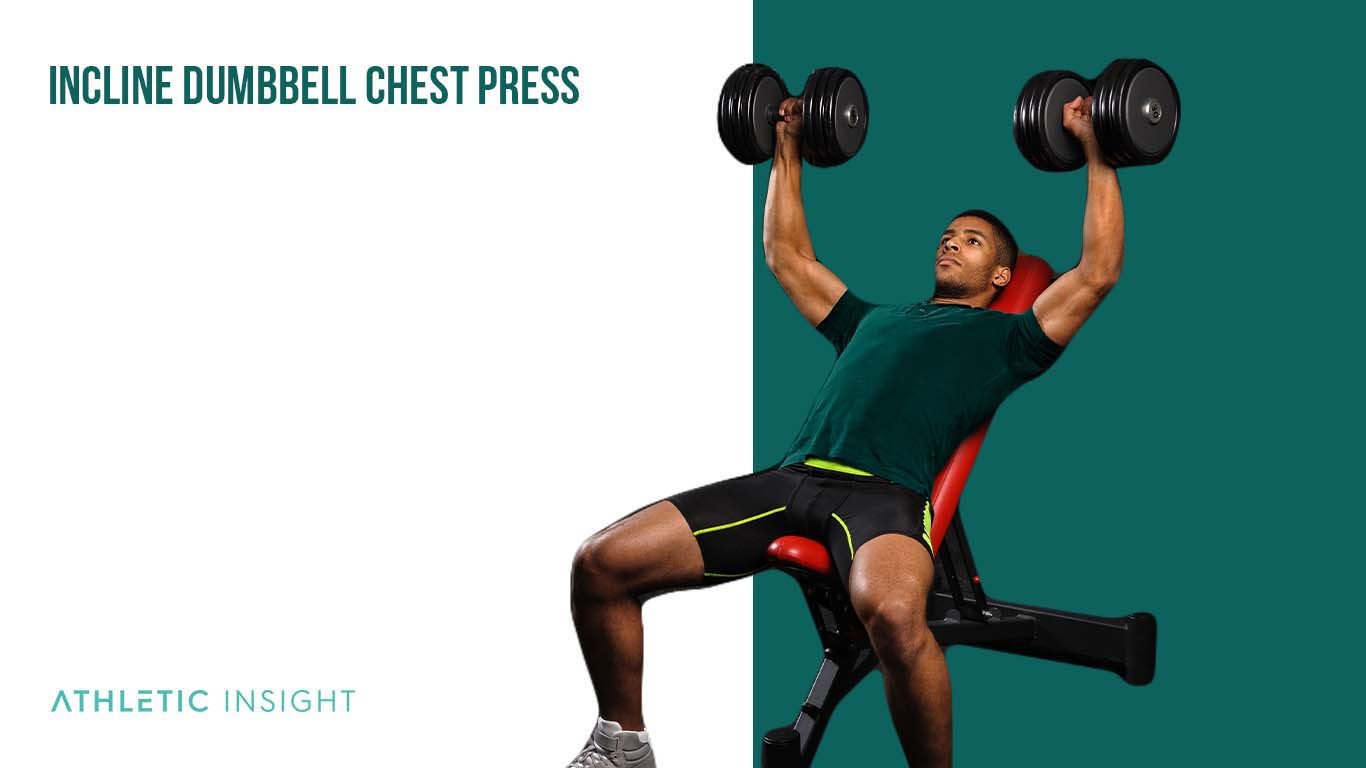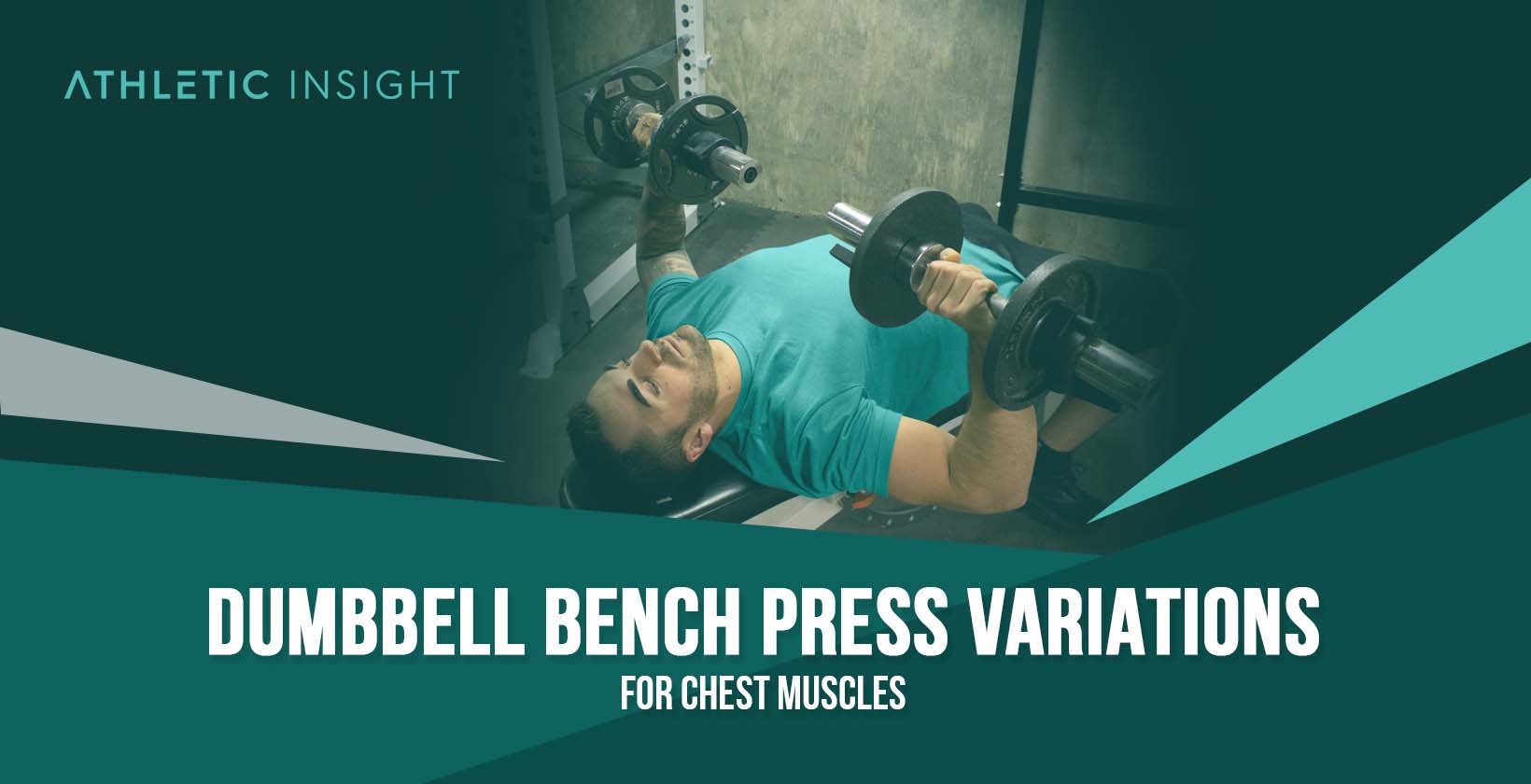The dumbbell bench press is a dumbbell flat bench press exercise that focuses on your pectoral muscles (pectoralis major and pectoralis minor), deltoid muscles, and triceps brachii. The dumbbell press form is key to doing this exercise correctly, as the proper dumbbell press form keeps your elbows in, your elbows locked out at the end, and going through a full range of motion.
Dumbbell pressing can help with upper body strength and power for athletes, bodybuilders, and weightlifters. So, what do dumbbell presses work? The answer is the pectoral muscles and the overall upper-body strength. Bodybuilders and weightlifters can also benefit from doing the dumbbell bench exercise, as it helps with other activities like push-ups, pull-ups, overhead press, and Olympic lifting.
The dumbbell bench press has numerous variations that can be used for beginners and advanced users who want to personalize their workout. These dumbbell bench press variations are exercise movements that are meant to enhance the traditional dumbbell bench press and are used to further develop additional muscles and improve strength.
1. Incline Dumbbell Chest Press
The incline dumbbell chest press is a dumbbell bench press variation that focuses on the pectoralis major head, anterior deltoids, and triceps. The incline makes the individual put more strain on the pectoralis major when compared to the flat bench press on the pectoralis minor. This exercise is the best option for bodybuilders and weightlifters who want to build their chest muscles.

Alternatives of the incline dumbbell chest press are the flat bench DB chest press, incline barbell press, cable fly bench press, and standing cable fly. One mistake many individuals may make doing this exercise includes not bringing the dumbbells down evenly. Users can avoid this mistake by going through a full range of motion and keeping their back on the bench.
The toughness level of this exercise is a 5 out of 10 since the incline makes it harder to move heavyweight. Individuals should learn how to do the flat bench dumbbell bench press before moving onto the incline dumbbell chest press.
2. Decline Dumbbell Chest Press
The decline dumbbell chest press is a variation that focuses on the clavicular head of the upper pectoral muscle and the sternal head of the lower pectoral muscle. The purpose of this exercise is to focus on the lower pecs, whereas the incline bench focuses on the upper pectorals.
The decline dumbbell chest press alternatives are the decline barbell chest press, decline push up, and incline dumbbell chest press. One mistake people may make doing this exercise is not going through a full range of motion. The purpose of this exercise is to focus on the lower pectorals through a full range of motion and bring the dumbbells down evenly.
The toughness level of this exercise is a 6 out of 10 since it will be harder to keep the weights directly above your chest. The decline dumbbell chest press is more challenging than the incline press, so only advanced users should try this exercise.
3. Dumbbell Floor Chest Press
The dumbbell floor chest press is a dumbbell chest press variation that focuses on the triceps since your arms have to go through a full range of motion and touch the floor before coming back up. This exercise is good for athletes who do not need to do the bench press for their sport.

The dumbbell floor chest press alternatives are bodyweight push-ups, barbell floor chest press, and barbell bench press. One mistake to avoid doing during this exercise is not going through a full range of motion and touching your elbows to the bottom. Weightlifters can avoid this by using the elbow touching the floor as the cue to bring the weight back up and by racking the bar properly.
The toughness level of this exercise is a 4 out of 10 since it is easier than the bench press using a barbell. The dumbbell floor chest press requires less range of motion than the bench press, making it a good choice for beginners who want to learn proper chest press form.
4. Dumbbell Wrist Rotation Chest Press
The dumbbell wrist rotation chest press is a dumbbell chest press variation that focuses on the deltoids and pectorals. With the rotation, the changing of the grip can affect the wrist, forearm, and deltoids, bringing more focus to the smaller muscles than the pectorals.
One mistake to avoid doing this exercise is improperly rotating the dumbbells. The ways to prevent this mistake are to focus on externally or internally rotating your wrist during the movement and keep the dumbbells at the same level during the entire range of motion. Alternatives of the dumbbell wrist rotation chest press are the neutral grip chest press, barbell chest press, dumbbell incline chest press, and cable chest press.
The toughness level of this exercise is 5 out of 10 since many people will have to focus on both pushing the weights and stabilizing the dumbbells during the entire range of motion.
5. Neutral Grip Dumbbell Chest Press
The neutral grip dumbbell chest press is a dumbbell chest press variation that focuses on the pectoral muscles, shoulder, and triceps. The neutral grip with the dumbbells places more of an emphasis on the triceps and the upper pectoral muscles while also reducing shoulder strain and reducing the focus on the lower pectoral muscles.
Variations of the neutral grip dumbbell chest press are the pronounced grip dumbbell chest press, chest dumbbell fly, incline neutral grip dumbbell chest press, and decline neutral grip dumbbell chest press. One mistake to avoid during the neutral grip dumbbell chest press is to keep the hands pronated instead of in a neutral grip. Individuals can avoid this mistake by focusing on maintaining a neutral grip throughout the range of motion and holding the dumbbells evenly spaced at all times.
The toughness level of this exercise comes to a 5 out of 10 since many will typically have to use a lighter weight for the neutral grip than they would with a pronated grip on the dumbbells.
6. Alternating Dumbbell Chest Press
The alternating dumbbell chest press is a dumbbell chest press alternative that focuses on unilateral movements and keeping the one weight stabilized above your chest. Since some people will have to focus on stabilizing one side and pressing the other side, it can tax both pectoral muscles in different ways during the movement.
Alternatives to the alternating dumbbell chest press are alternating incline dumbbell chest press, alternating decline dumbbell chest press, alternating cable fly incline chest press, and alternating cable decline chest press. One mistake to avoid while doing this exercise is to not keep the dumbbell stabilized. Weightlifters can avoid this mistake by keeping one weight straight over their chest and focusing on the single-side movement.
The toughness level of this exercise comes to a 6 out of 10 because those performing the exercise will have to focus on two movements.
7. Single-Arm Dumbbell Chest Press
The single-arm dumbbell chest press is a dumbbell chest press alternative that focuses on the pectoral muscles, deltoids, and triceps. Since you are only using one side, your core is also engaged in making sure you do not twist your body during the movement.
Alternatives to the single-arm dumbbell chest press are the two-arm dumbbell chest press, single-arm cable chest press, barbell bench press, and single-arm dumbbell incline chest press. A mistake to avoid while performing the single-arm dumbbell chest press is to twist your body during the motion. People can avoid this mistake by bracing their core and breathing out during the pushing motion.
The toughness level of this exercise comes to a 5 out of 10 since exercises will have to brace their core and avoid using momentum during the range of motion.
What are the Main Dumbbell Bench Press Exercises Variation Types?
The main dumbbell bench press exercise variation types include changing the bench type, either using an incline or decline bench, using a barbell, using a cable, using bodyweight alternatives, or changing the single-side to two-side exercises.

Which type of Dumbbell Bench Press Exercises Variation is good for weightlifters?
Weightlifters will benefit from exercises that will build their muscles and strength for their lifts. Weightlifters will typically do the bench press for their competitions, so doing bench press alternatives is helpful to improving their total barbell bench press weight.
Some of the best dumbbell bench press variation exercises suitable for weightlifters include the incline dumbbell chest press, decline dumbbell chest press, dumbbell wrist rotation chest press, neutral grip dumbbell chest press, alternating dumbbell chest press, and single-arm dumbbell chest press.
Which type of Dumbbell Bench Press Exercises Variation is good for athletes?
Athletes need to focus on overall total body strength, upper body power, and filing any discrepancies between both sides of the body. Athletes should concentrate on doing the dumbbell floor chest press and the single-arm dumbbell chest press to focus on upper body power and avoid injuries.
Which type of Dumbbell Bench Press Exercises Variation is good for bodybuilders?
Bodybuilders should use the incline dumbbell chest press to focus on the upper pectoral muscles, the decline dumbbell chest press to focus on the lower pectoral muscles, and the neutral grip dumbbell chest press to focus more on the deltoids. Bodybuilders want to focus on dumbbell bench press exercise variations that focus on building hypertrophy and defining the arms and pectorals.
What muscles work for Dumbbell Bench Press Exercises?
The main muscles worked during the dumbbell bench press exercise include the pectoralis major, pectoralis minor, anterior deltoids, and triceps brachii. The dumbbell bench press is an effective chest workout that can replace the traditional bench press.
Which type of Dumbbell Bench Press Variation is difficult to perform?
The dumbbell bench press variation that is the most difficult to perform is the decline dumbbell chest press, as it is hard to keep the weight above your chest when your body is tilted downwards.
Which is the most effective between Incline Dumbbell Bench Press and Decline Dumbbell Bench Press?
The incline bench press works the upper pectoral muscles, whereas the decline dumbbell bench press works the lower pectoral muscles, meaning both are effective for different purposes.
Can Neutral Grip Dumbbell Chest Press be good for shoulder discomfort?
Yes, a neutral grip dumbbell chest press is good for relieving shoulder discomfort and strain. Furthermore, it has additional benefits that show why it should be incorporated into a strength program.
- Application to sport – Neutral grip can be used for sports that need to strengthen the shoulders and increase range of motion, such as tennis and baseball.
- Joint-friendly for high-volume
- Triceps and chest growth
- Mind muscle connection
Are there any Dumbbell Bench Press Alternatives?
There are numerous dumbbell bench press alternatives, such as the following.
- Incline dumbbell chest press – Can be used to target the pectoralis major.
- Decline dumbbell chest press – Used to target the pectoralis minor.
- Dumbbell floor chest press – Useful for beginners who do not have a full range of motion.
- Dumbbell wrist rotation chest press – Helpful to target anterior and posterior deltoids
- Neutral grip dumbbell chest press – Reduces shoulder strain for athletes.
- Alternating dumbbell chest press – Works core strength and unilateral strength.
- Single-arm dumbbell chest press – Taxes the core strength and stabilization.



